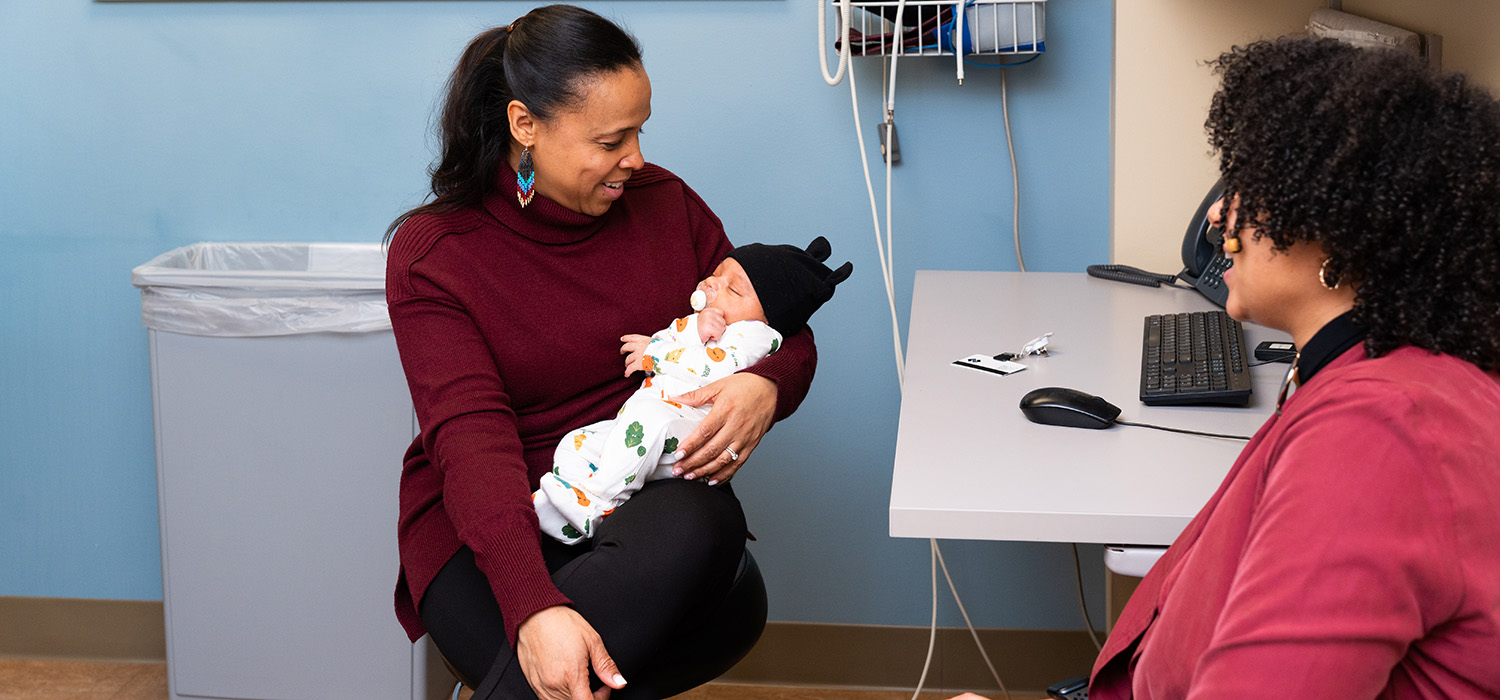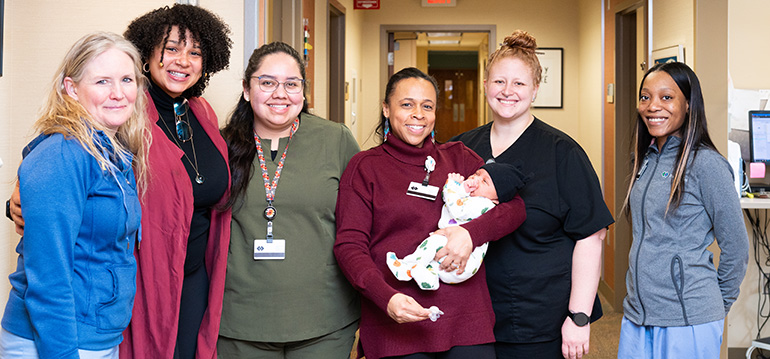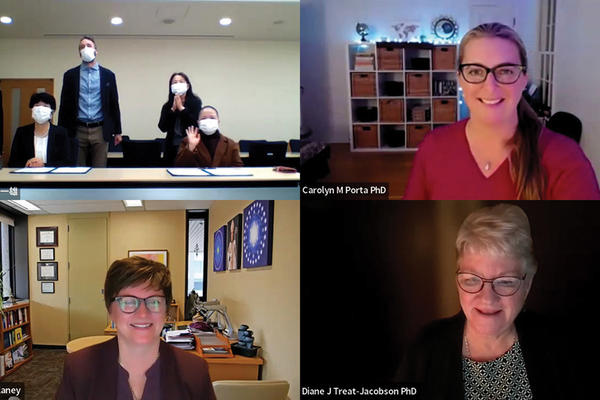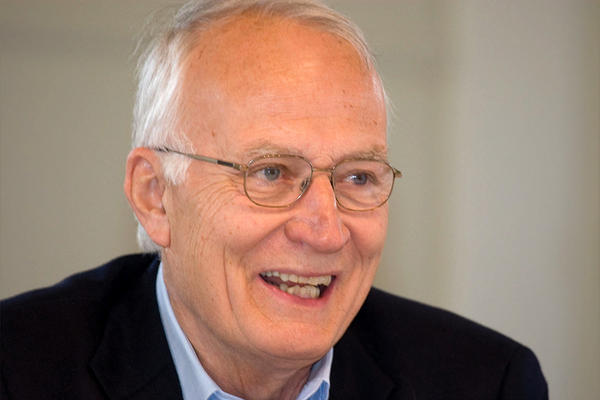An advocate for patients and the profession
Futrell Carter says being a nurse-midwife is what she’s meant to be
May 3, 2023

Above: Sakeena Futrell Carter talks with a new mom at the Park Nicollet clinic in Minneapolis.
Sakeena Futrell Carter, DNP, APRN, CNM, was a labor and delivery nurse for 10 years before deciding to earn a Doctor of Nursing Practice degree at the University of Minnesota and leave labor to become a women’s health nurse practitioner.
“I wanted a little bit more Monday through Friday, 9 to 5 in my life, but after seven years of that, I missed birth,” says Futrell Carter, who returned to the University of Minnesota to earn a graduate certificate in nurse-midwifery.
“I missed that in labor and delivery and during birth, you develop this really intense, close relationship. It’s, most of the time, the most significant point in a person’s life and to be a part of it is always a blessing. I always thank my patients after,” says Futrell Carter. “It doesn't get old. It gets tiring and exhausting, but it does not get old.”
Partnering with patients
Futrell Carter currently practices with a group of 14 nurse-midwives at Park Nicollet, at clinics in Minneapolis and St. Louis Park. “We’re pretty busy. We do on average just under 800 births a year just within our group of midwives,” says Futrell Carter, who says she averages about 50 births a year. She has a call day every week and she’s in clinic seeing patients for prenatal care, postpartum care, full scope annual visits and problem visits.
Futrell Carter says being a good nurse-midwife takes compassion, listening and the ability to anticipate someone’s needs. An appreciation for the partnership between provider and patient is also key. “People will say, ‘Do I have to do that?’ And I'm like, ‘You probably won’t hear me ever say that you have to do anything. Wrap your heart around the plan, that's my big thing. Whatever we're doing, I need you to wrap your heart around it or it's not going to work.’”

She can’t imagine being a nurse-midwife without the labor and delivery experience she had as a Registered Nurse, but being an Advanced Practice Registered Nurse is a distinctly different experience. “You are in charge of the room as the midwife,” she says. “You’re not in charge of the patient and her family, but you have to see everything and also be very present in what’s happening with that birthing person.”
While the majority of the clinic’s patient population is Caucasian, she says she tends to draw women of color because they seek her out. “I think it's amazing. They’ll come in and say, ‘I’m seeing you specifically because I looked up your profile and you’re a woman of color.’”
There are four midwives of color in her group, which isn’t by luck. “I happen to be fortunate enough to work within a very receptive group of midwives, and so I talk a lot within our group about diversifying,” she says.
Another important piece to being a Black midwife for Futrell Carter is raising awareness about the fears that women of color experience. “I have women come in and they’re like, ‘I know that as a Black woman, I’m more at risk to die because of this pregnancy.’ And I tell them, ‘I can't promise you that I’ll be there for your birth. What I can promise you is that I truly trust this group of women around me who might potentially be caring for you. I promise that they will honor you and take care of you to the best of their abilities.’”
A commitment to advocacy
Hand in hand with her commitment to catching babies is her commitment to advocacy. She’s supported doulas of color and raised awareness that people who are pregnant in Minnesota qualify for health insurance, so that they know that cost shouldn’t be a barrier to receiving care.
During her term on the Minnesota Board of Nursing, she advocated for more diversity on the board and for the board to govern certified midwives, who are not nurses. “There’s a significant cost benefit in not having to become an RN and then transition into a master’s program, which opens up the profession of midwifery to more people,” she says. Eventually it gained the board’s support, although there is not a certified midwife program in Minnesota.
She’s served on the Maternal Mortality Review Committee for the state of Minnesota, which involved analyzing every maternal death in the state. “None of it is good, none of it is happy. The outcomes are never good. But you know that you’re being part of hopefully preventing this from happening to another birthing person,” she says.
Futrell Carter also serves as First Lady of Minnesota’s Capitol City. She enjoys working alongside her husband, Saint Paul Mayor Melvin Carter, and feels fortunate that their passions and goals align.
Where nurse-midwifery is headed
As she looks at the future of nurse-midwifery she sees that people are becoming more aware of midwifery care and the benefits of it. She also sees that nurse-midwives and physicians are developing better relationships. “I only know my practice, but I strongly feel like we’re developing better relationships with our physician partners,” she says. “I don't know if that’s unique to our practice or just the trust we’ve built, or maybe, hopefully, that's happening nationwide and worldwide.”
She hopes that as a profession, nurse-midwifery grows in diversity, with more men, people of color and people of varying socioeconomic statuses, all the while focusing on patient outcomes. “I hope that we continue to do what we’re doing in practice that helps those mortality rates to come down,” she says.
As the field of nurse-midwifery continues to grow and evolve, Futrell Carter knows she’ll be experiencing it firsthand. “I love my work. I love my patients. I love my partners,” says Futrell Carter. “Truly, and I tell my husband this all the time, for both of us, we truly feel like we are living what we were put on this Earth to do. And that's amazing. I don't know that everyone has that feeling in life.”


